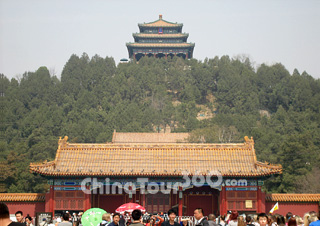 Beijing Jingshan Park
Beijing Jingshan Park
Jingshan Park, a beautiful royal garden, is located in Xicheng District, immediately north of the Forbidden City on the central axis of Beijing with an area of 230,000 square meters (about 57 acres). It was first built in 1179 specially for the royal families to make sacrifices to the ancestors. Standing on the summit of Jingshan, visitors can get a fully clear view of Beijing particularly the Forbidden City.
Jingshan Park is founded on Jingshan Hill which rises to a height of 48 meters (157.5 feet). It was originally named as Wansui Hill (Long Live Hill), Zhen Hill or Meishan Hill (Coal Hill), because coal was later piled there, and Feng Shui Hill because it was constructed north of the Forbidden City to protect it from cold northern winds. It was finally called Jingshan Hill in 1655 during the Qing Dynasty (1644 - 1911).
There stand five pavilions on the summit of Jingshan hill. They are of the typical Chinese structure with two-story thatched roofs and neatly built stairs. The highest pavilion is called Wanchun Pavilion, from which visitors are able to have a grand view of the resplendent and splendid Forbidden City in the south, the dignified Bell and Drum Towers in the north, as well as the White Dagoba in the west. The other four pavilions are built at the four corners of the park. Each of these pavilions had a copper statue of Buddha symbolizing the five kinds of tastes: acid, spicy, bitter, sweet and salty. They were once looted and destroyed in the wartime and the replacement Buddhas in display now were made in 1999.
There are several palaces at the foot of the hill. At the northern foot of the hill is the Shouhuang Palace (Hall of Imperial Longevity), where the portraits of the ancestors of the imperial family were housed. To the east of the Shouhuang Palace are located the Yongsi and the Guande Palaces which were used as the mourning place for the decreased emperors and empresses of the Qing Dynasty. Currently, Shouhuang Palace and Guande Palace function as children's palace and library.
At the foot of the hill there also stands a tree where it is believed that last emperor of the Ming Dynasty (1368 - 1644), Chongzhen took his life by hanging himself on the tree in 1644.
Jingshan is famous for its peonies and ancient trees. It is best to appreciate over 200 varieties of peonies inside the park from late April to mid-May. Jingshan park is also a popular place for elderly folks to dance, sing and attend some cultural activities. Being one of the hottest scenic spots, it draws more and more tourists.
![]() Entrance Fee: CNY 2 (Fee of exhibition is not included)
Entrance Fee: CNY 2 (Fee of exhibition is not included)
![]() Opening Hours: 06:30 - 21:00
Opening Hours: 06:30 - 21:00
![]() Bus Routes:
Bus Routes:
A. Take Bus No. 58, 60 or 111 and get off at Jingshan Dongjie (East Jingshan Street).
B. Take Bus No. 5 and get off at Jingshan Xijie (West Jingshan Street).
C. Take Bus No. 819 and get off at Jingshan.
D. Take Bus No. 101, 103, 109 or 814 and get off at Forbidden City.








